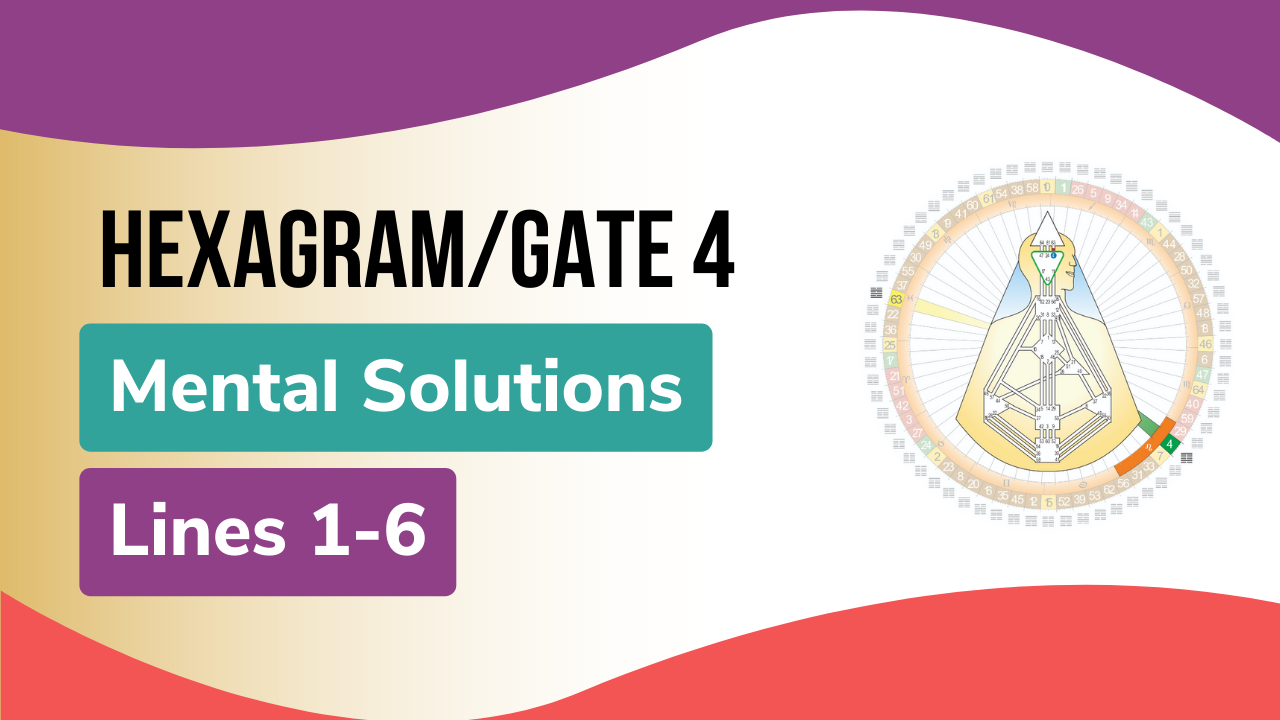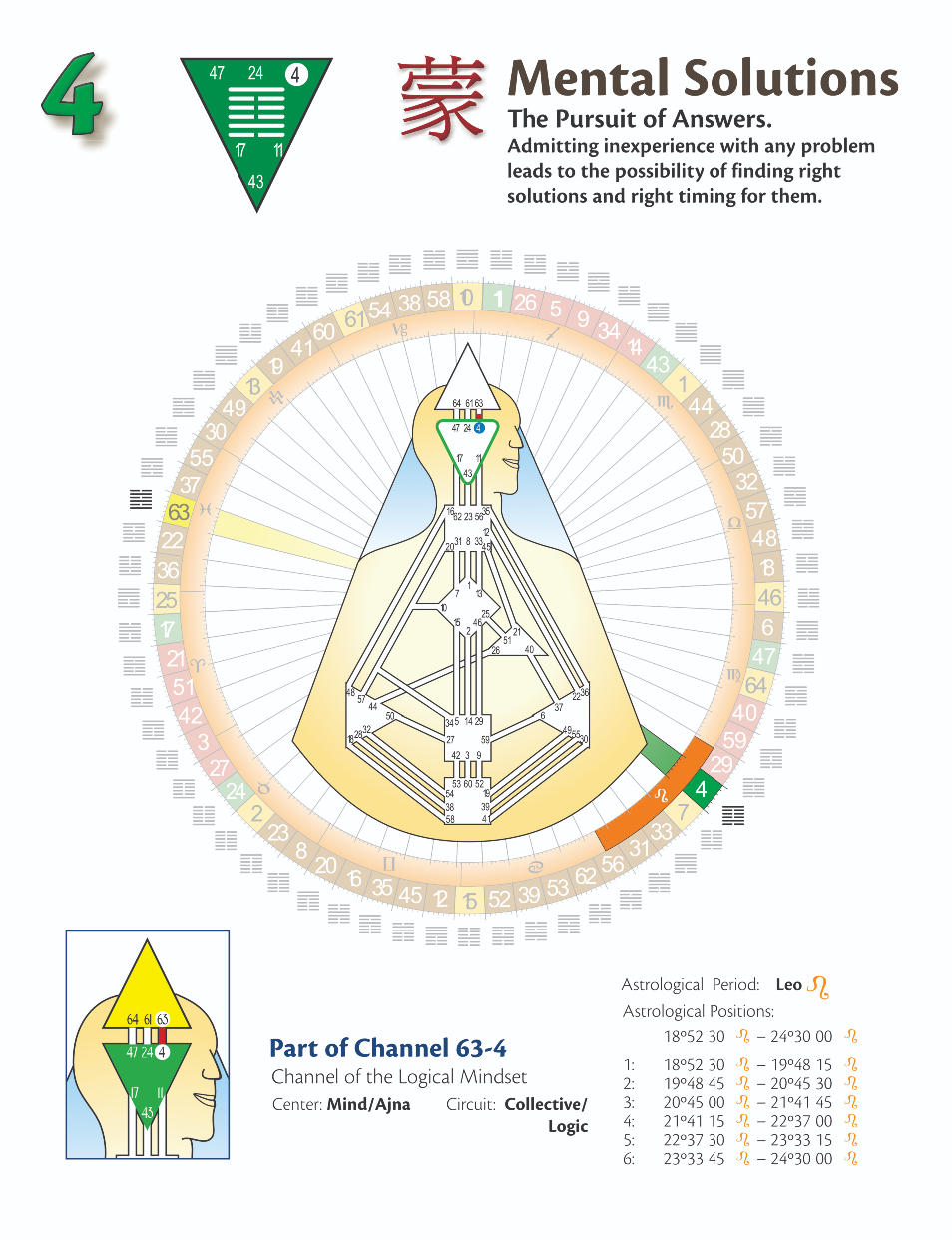Last time, we explored Hexagram 7, which showed us how we can learn to combine our intentions and work together towards a common future. Now, the Sun is moving into Human Design Gate 4, which we call “Mental Solutions.”
In the traditional Chinese, the translation is something like “youthful folly,” indicating that things here might not always be thought through all the way; that wisdom isn’t necessarily fully applied to whatever the mental solutions might be.
One thing to understand about this Gateway is that it’s not personal. It is not about fixing people. It’s not about fixing the way people go about their lives. It has to do with finding solutions to situations, not people. It’s about arranging the circumstances around people in ways that they work better.
So, why would we call a solutions mechanism “youthful folly”? It has to do with impulsiveness. With the 4th Gateway, there is a push to find an answer. There’s a tendency to jump to conclusions in search of solutions because it has this drive to solve things quickly. And as we all know, a “quick fix” isn’t always the most methodical, well thought out solution to a problem.
Being quick with solutions does not necessarily solve problems or lead to lasting satisfaction because mental solutions are, at best, partial and temporary. It doesn’t matter how great the solution sounds, eventually the problem will pop up again, and we’ll see that the “solution” only papered over the cracks. It didn’t solve the issue completely. But that’s not to say that these mental solutions can’t come in handy. There’s a time and place for them, and we’ll see that as we go through the Hexagram.
Let’s see what we find as we go through Human Design Gate 4 line by line:
First Line: Learning
The first line is called “Learning: Good timing is a gift that enhances all problem solving.” Not every situation requires an immediate fix. So, this line is about knowing when to get involved and when to sit back. Is there really a need for a solution in this particular moment? You’re always learning the art of recognizing when and where to provide mental solutions. It’s a lifelong thing.
Something that became very evident with the emergence of Human Design is that when it comes down to making decisions, the mind is not the place to go. The mind is an archive and a computer. It’s a great resource for looking through all the different possibilities that could potentially take place. But when it comes to pulling the trigger on a decision, that comes from your Authority, not your intellect.
You tend to implement resolutions that ignore a natural timing to problem solving. Again, this is all about the patience of learning your timing, of trusting your authority, of not simply jumping in because you think you can fix whatever’s going on. Everything has its right timing, and when you can tune into that timing, you’ll know whether or not the quick fix is actually needed at all.
Second Line: Kindness
The second line always has a natural approach to problem solving. And here, the line is called, “Kindness: Recognizing that everyone has their own strengths and weaknesses.” Some people need things fixed for them, others don’t. But in recognizing that everybody has their own appreciation about life and the things that are and are not working for them, you allow for a more natural pathway to solutions to come about.
You’re very happy in your own company, and happy to engage with novel concepts that might be outside of the ordinary, logical approach to things. You’ll come to appreciate that not everyone is going to understand your viewpoints. Even when you’ve got the perfect solution, there will be times that other people simply can’t see it at all. They just can’t recognize what it is that you’re trying to point out.
In a hurry, you might sometimes take advantage of other people’s slowness and disorder. You might feel like people are just getting in your way. They can’t sort it out for themselves so you’re just going to push your way in and get it fixed. But again, we often find out that the quick fix won’t last and wasn’t needed in the first place. And if you had just left people to their own devices, perhaps they would have sorted it out for themselves in a way that brings more satisfaction.
Third Line: Carelessness
Third lines are never quite sure if they’re going to fully commit to something or not. Here, the line is called, “Carelessness: A love of solutions that may not actually solve problems.” If you allow it, your lazy mind will settle for an easy solution rather than a relevant one. I think we can all relate to this on some level. We have an idea and get really excited about it. We think it’ll be so great if we tried it out, but in reality, it’s not actually aligned with the needs of the situation.
You have a potential to use solutions for appearances rather than for effectiveness. Sometimes solutions can act as part of a façade. It might look good, but it really doesn’t solve anything. This is not to say there’s anything wrong with the fourth Gateway. It’s very earnest in putting out these solutions. But some of them just fall very short of what it is that’s really needed.
Any tendency for diminished responsibility will lead you to meager accomplishments. Essentially what we’re seeing here is that when you just whitewash something, when you allow yourself to carelessly put a façade over something, rather than tuning into what’s really needed or relevant, you’re going to end up with meager, unsatisfying outcomes.
Fourth Line: Justifying
The fourth line is called “Justifying: A busy mind that somehow is going to find an answer for everything.” There’s an urgency with the fourth line to get everybody involved. And this urgency can lead to a tendency to just to put out any solution at all and then justify it after the fact, even if doing so requires them to bend the laws of logic a bit.
We’re all familiar with the expression, “think outside the box,” for a solution that lies outside the normal ways of looking at things. But, when we are looking at the fourth line here, there is no box. Logic need not apply. You find mental formulas, realistic or not, for every conceivable life situation. You can go from A to B and then all around the Universe and back in order to justify your mental solutions.
If you try applying mental solutions for everything, you’ll be frustrated when they don’t work. This is the difficulty with the fourth line. Since the fourth line is so concerned with everyone working together and being on board with one another, the possibility of rejection looms large. If your solutions are not appreciated or understood, you can sort of collapse into yourself and feel like you don’t really belong.
Fifth Line: Being Broad-minded
Fifth lines always have a leadership quality. They have a way of pointing things out to other people. And here, the fifth line is called “Being Broad-minded: Solving difficulties by being open to any and all resources.” With a gift for problem solving, you sometimes diminish others’ lack of ability to understand. You have a natural ability to come up with solutions in a way that people just get.
You have a cleverness for solving problems that is teachable to other people. And this is a great gift. Not only can you provide solutions in a way that people can understand, but you can actually introduce whole solution mechanisms to other people which show them how to think things through clearly on their own. In other words, you can give a man a fish AND teach him how to fish at the same time.
You’re potentially cynical if you have to tailor your solutions to meet others’ approval. Your natural ability to see things clearly means that you often find yourself living in a projection field. Other people project their needs, wants and expectations onto you. They come to you to sort things out for them. So, there’s a tendency to get pulled into situations where you’re constantly rescuing everybody around you, rather than being very purposeful, direct, and clear in what it is that’s actually needed for the current situation.
Sixth Line: Cleverness
Human Design Gate 4 with the sixth line, as well as Gate 47 with the sixth line are two lines that just fascinate me. Gate 47 is the abstract way of making sense out of life. Gate 4 is the logical way of seeing how life is going to progress. And I call these two lines “booby traps”. Wherever you see this in somebody’s design, it means they have incredibly clever minds. They can sort out anything. They can make sense out of things that don’t make any sense. But, I call them booby traps because all of us have been so thoroughly trained to use our minds, to think things through, add up the pros and cons and so on, but in Human Design we know that the real decision-making comes from the Authority, not the mind. Sooner or later, you realize it doesn’t matter how clever your brain is, if you’re not tuned into your Authority, you’ll find yourself in trouble. That’s why I call the sixth line “Cleverness: “Too clever for your own good” if you think your mental solutions endure!”
Unless disciplined, your mind will always try to dominate life with its solution mechanism. Your mind just takes over and runs the show until you realize that it isn’t really working for you. You can’t always think your way through situations. You have to go deeper into yourself. And this requires discipline. Are you in charge of your mind or is your mind running your life?
Mental discipline comes through your patience, awareness and applied experimentation. It’s a practice. It’s the practice of going into yourself, into your Authority before acting on the urge to fix everything. We all have to be very watchful about falling in love with our own cleverness and thinking we’re way ahead of everyone around us. The mind is a fantastic device. It’s an excellent bio-computer. But the 4th Gateway has to learn patience. Is a solution needed? Is the timing right to offer or provide a solution? Am I the one who needs to get involved?
If you’re invited over to a friend’s house for dinner and instead of greeting them when they open the door, you just walk straight in and start straightening their crooked picture frames and dusting off their dirty bookshelves, yes you are “fixing” things, but you’re also being extremely rude. You are inserting your mental solutions where they were never needed in the first place. It comes back to the question: “Does it really need to be fixed?”
That’s Human Design Gate 4. We’ll check in again soon. In the meantime, if you’d like to learn more about how your Design informs and shapes your life, get your Free Human Design Report today.




